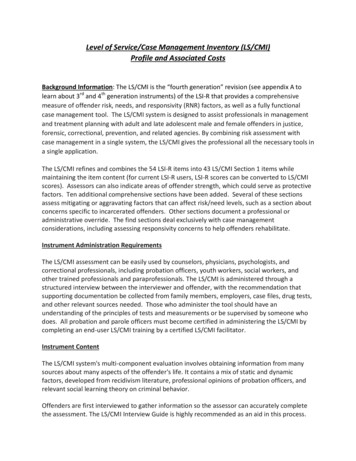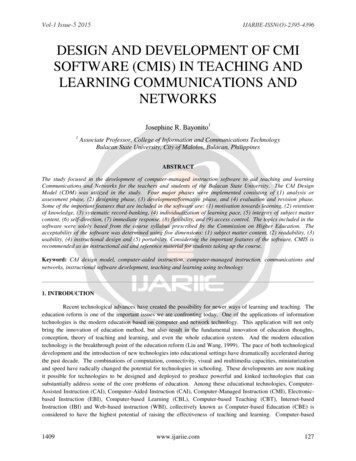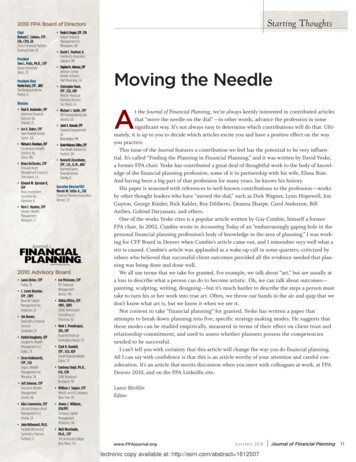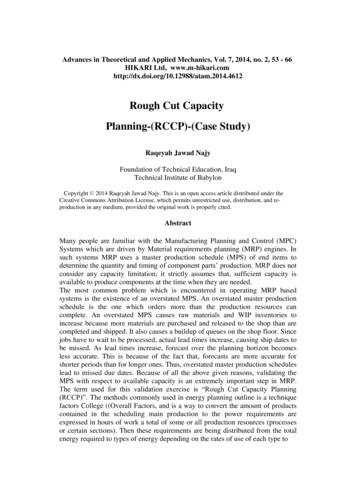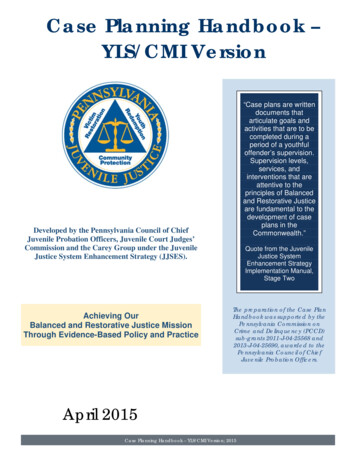
Transcription
Case Planning Handbook –YLS/CMI Version“Case plans are writtendocuments thatarticulate goals andactivities that are to becompleted during aperiod of a youthfuloffender’s supervision.Supervision levels,services, andinterventions that areattentive to theprinciples of Balancedand Restorative Justiceare fundamental to thedevelopment of caseplans in theCommonwealth.”Developed by the Pennsylvania Council of ChiefJuvenile Probation Officers, Juvenile Court Judges’Commission and the Carey Group under the JuvenileJustice System Enhancement Strategy (JJSES).Achieving OurBalanced and Restorative Justice MissionThrough Evidence-Based Policy and PracticeQuote from the JuvenileJustice SystemEnhancement StrategyImplementation Manual,Stage TwoThe preparation of the Case PlanHandbook was supported by thePennsylvania Commission onCrime and Delinquency (PCCD)sub-grants 2011-J-04-25568 and2013-J-04-25690, awarded to thePennsylvania Council of ChiefJuvenile Probation Officers.April 2015Case Planning Handbook – YLS/CMI Version; 2015
Page 1Case Planning Handbook – YLS/CMI VersionThe Case Planning Handbook augments the case planning efforts of the Juvenile Justice SystemEnhancement Strategy (JJSES), as described in the Quality Case Planning Curriculum. The Handbook wasdeveloped through the joint efforts of representatives from the Pennsylvania Council of Chief JuvenileProbation Officers, the Juvenile Court Judges’ Commission, and The Carey Group.The Handbook is designed to assist staff who have been trained through the Quality Case PlanningCurriculum to select case plan goals and activities that align with criminogenic needs and that meet theSMART objectives (specific, measurable, achievable, realistic, and timebound). As such, the Handbook isintended to be used as a guideline or point of reference. The probation officer will need to exercisejudgment as to which goals and activities to select based on the unique traits and circumstances of theindividual.The reader will notice a few things that are noteworthy:1. The goals are written in strength‐based terms. Although the objective is to teach skills that addressskill deficits, the strength‐based wording is intended to maximize motivation and desire to engage.2. The activities listed follow the SMART format, except for the “T” portion of SMART (“timebound”).An example of a timebound activity is “By September 30, identify five times in the last 30 days thatyou lost control of your anger.” For the purposes of this document, this activity will simply read“Identify five times in the last 30 days that you lost control of your anger.” The correctionsprofessional will need to insert specific times based on what is realistic for the individual.3. Some community service referral interventions are listed in the Handbook. Community‐basedservices are location‐specific; therefore, each department will need to insert their own localprograms. In doing so, departments are urged to not list every possible service, as some servicestend to fall short of risk reduction objectives; staff should be encouraged not to use these unlessthere are extenuating circumstances.4. Many traditional interventions are not listed in the Handbook because the evidence does notsupport their efficacy (e.g., awareness classes, programs that use lecture or insight to teach). Theintent is to include in the Handbook only those interventions that will lead to behavior change andnot to encourage placement in those programs that do not significantly contribute to riskreduction.5. The case plan goals, activities, and interventions listed in the Handbook are not all‐inclusive.Departments are urged to add to the listing as they discover other goals and activities that areuseful to the probation officer and offender.Instructions: The Case Planning Handbook is organized according to the eight criminogenic needs. Theselected goals for each criminogenic need are ones to which a medium or high risk offender mightDeveloped by The Pennsylvania Council of Chief Juvenile Probation Officers, the Juvenile Court Judges’ Commission,and The Carey Group, under the Juvenile Justice System Enhancement Strategy (JJSES)
Page 2commonly aspire. Case plan activities are built around these goals. These activities include shortassignments that offenders can do as homework between appointments.Skill Deficits. As we discussed, unlawful acts are influenced by dynamic risk factors, or criminogenicneeds. If we can address those needs we can reduce the likelihood of future illegal behavior. Weaddress them through teaching skills. Skill deficits may exist because the individual’s environmentdid not afford the opportunity for role models to teach, demonstrate, or model prosocial skills. Or,in some cases, the very skills that were taught and modeled were counterproductive to a legallifestyle such as learning how to fence goods, expressing anger to gain influence over others, usingpower over individuals against their will, or physically assaulting others to establish a reputation.Criminogenic needs are fairly broad when determining what to target in a case plan. For example,teaching a skill to address the need of antisocial personality could include anger management,impulsivity, problem solving, or risk taking just to name a few. The criminogenic need of antisocialpeers might require us to teach skills around knowing the difference between a positive andnegative influence, assertiveness, or recognizing high risk situations. In other words, eachcriminogenic need encompass a number of potential skill deficits. It is unlikely that the conditionsof supervision will identify specific skills that need to be addressed; this requires probation officerjudgment usually exercised during the case planning process. If we are going to help reduce risk ofantisocial conduct we need to zero in on the right skill deficit(s) for each individual based on theircriminogenic needs. Our case planning goal, then, is to proactively and precisely address those skilldeficits most likely contributing to the individual’s illegal and antisocial conduct and to findopportunities to model, teach, and reinforce those skills in increasingly difficult situations.Interventions. Following each list of goals and activities is a table with common interventions.While all of these options may not be available to every probation department, most will be. Inaddition, departments are encouraged to insert those interventions that are unique to their area.The list should be narrow enough so as not to overwhelm readers, and it should include only thoseinterventions that will have the greatest impact on recidivism, but it should be diverse enough tomeet the unique needs of individual offenders.Finally, interventions cluster around the criminogenic need that they are best suited to address.While some of these interventions may have value in addressing other criminogenic needs, they arenot specialized enough to warrant their placement there. For example, it could be argued thatemployment is a way to fill one’s day with prosocial activities; therefore, “employment” could belisted under “Leisure.” While this is a logical statement, the goal of leisure is to fill one’s free time(outside of work and school) with recreational activities that build physical, mental, and spiritualwell‐being. It is for that reason that “employment” is not listed as an intervention under “Leisure.”The probation officer should use the Case Planning Handbook as follows:1. Identify the criminogenic need that will be part of the case plan.2. With the offender’s input, select the case plan goal that best addresses that criminogenic need; theHandbook provides some common examples.Developed by The Pennsylvania Council of Chief Juvenile Probation Officers, the Juvenile Court Judges’ Commission,and The Carey Group, under the Juvenile Justice System Enhancement Strategy (JJSES)
Page 33. With the offender’s input, select the skill that could help the offender meet their goal; theHandbook provides some common examples.4. With the offender’s input, select a few activities that will lead the offender toward their goal. Theseactivities should be listed on the case plan with a timeframe that indicates when each one will becompleted. The probation officer should avoid recording too many activities at once; circumstancesmay change as the offender works toward the goal, so activities may have to change. TheHandbook provides a number of suggestions for activities, all of which tend to build on the previousactivity. The probation officer and offender may wish to use some of those activities and notothers, or develop their own wording based on the offender’s circumstances.5. Finally, the table at the end of each criminogenic need lists interventions that can be selected inlieu of, or in addition to, some of the proposed case plan activities. These interventions are deemedto be effective in reducing risk and can be useful in helping the probation officer and offenderaddress the case plan goal.Developed by The Pennsylvania Council of Chief Juvenile Probation Officers, the Juvenile Court Judges’ Commission,and The Carey Group, under the Juvenile Justice System Enhancement Strategy (JJSES)
Page 4Attitudes and OrientationAttitudes and Orientation Definition:Offenders are more likely to recidivate if their attitudes, thoughts, and beliefs justify harmfulbehaviors that result in illegal activities. These attitudes, thoughts, and beliefs include minimizingthe consequences of their actions, blaming others, desiring control and power over others, havinga sense of entitlement, etc. Offenders with attitudes, thoughts, and beliefs that put them at risk forillegal behavior often view the world as being unfair, which can lead them to rationalize stealing orhurting others, or they may believe that the world is a place where only aggressive people survive.Offenders who do not engage in justifications or make excuses for their behavior, who try to actresponsibly toward others, who respect society’s laws and rules and think that they are mostly fair,and who regret their past illegal behavior are more likely to steer away from crime or delinquency.Case Plan Goal A: Develop thinking skills that help me make decisions that will support lawfulbehavior and a healthy, successful lifeSkill 1: Take full responsibility for actions (e.g., be truthful even when there might benegative consequences; don’t minimize/make excuses)Possible Activities:‐ Identify and write down five times when you attempted to avoid taking responsibility‐ For each of the five times, write down what you were trying to avoid‐ For each of the five times, describe the worst thing that could have happened if you hadaccepted responsibility and possible positive results had you accepted responsibility‐ For four weeks, keep a journal of every time you 1) avoid responsibility (describe theresults) and 2) are tempted to avoid responsibility but, instead, take responsibility(describe the results)‐ Practice making amends for negatively impacting someone by admitting what you didwrong to the affected person; or‐ Complete one or more of the worksheets listed in the Interventions table belowSkill 2: Avoid thinking traps that can lead to things that are harmful to selfPossible Activities:‐ Identify which of the eight thinking trap(s) you tend to fall into‐ List the consequences you could or have experienced for each of your traps‐ Provide three examples when you fell into one of your thinking traps, and describe whathappened as a result‐ List at least three times in the past 30 days when you stopped yourself from falling into thethinking trap, and describe what happened as a result; or‐ Complete one or more of the worksheets listed in the Interventions table belowDeveloped by The Pennsylvania Council of Chief Juvenile Probation Officers, the Juvenile Court Judges’ Commission,and The Carey Group, under the Juvenile Justice System Enhancement Strategy (JJSES)
Page 5Skill 3: Understand the thought–feeling–action link and how to apply it to my lifecircumstancesPossible Activities:‐ Identify five times you made a decision that resulted in a loss of privileges or freedom‐ For each time, list your thoughts that led to your decision; then, list three replacementthoughts for each of those five times that could have led to more positive outcomes‐ Apply the thought–feeling–action link to a new situation where your thoughts led to apositive outcome; or‐ Complete one or more of the worksheets listed in the Interventions table belowSkill 4: Understand what triggers thinking that is harmful, and develop a plan to preventnegative, automatic responses to those triggersPossible Activities:‐ Make a list of at least five people, places, or things that trigger your behavior‐ For each of those triggers, identify at least two possible responses that would likely lead toa positive outcome for you‐ Select two of your most positive trigger responses‐ Review your relapse plan with two people who want you to be successful; get their input;write down how those two people can support you in preventing relapse; or‐ Complete one or more of the worksheets listed in the Interventions table belowCase Plan Goal B: Identify and act on values to live by that will support my successSkill 1: Hold a set of values that uphold the dignity, safety, and independence of self andothersPossible Activities:‐ Identify two people with ethical values and list their values and characteristics; give oneobserved example for each value‐ Identify which values you hold and which you do not‐ Write a personal code of ethics; ask two people to review it and give you feedback‐ For a month, keep a journal of every time you uphold your personal code of ethics andevery time you do not; for those times when you did not uphold your personal code ofethics, discuss with your PO what prevented you from doing so; or‐ Complete one or more of the worksheets listed in the Interventions table belowSkill 2: Make responsible, moral choices when confronted with ethical dilemmas‐Define what it means to make a good moral choice; list what conditions must be met foran action to be considered a good moral choiceDeveloped by The Pennsylvania Council of Chief Juvenile Probation Officers, the Juvenile Court Judges’ Commission,and The Carey Group, under the Juvenile Justice System Enhancement Strategy (JJSES)
Page 6‐‐‐‐Identify five examples when you would find it difficult to make a good moral choice, andexplain whyList five rules that you want to live byFor a month, list each time you are able to live by your five rules and each time you arenot; decide whether you want to modify your five rules; orComplete one or more of the worksheets listed in the Interventions table belowInterventions for Attitudes and OrientationOne‐on‐One Supervision AppointmentsCommunity Service Referral OptionsAccountability LadderAggression Replacement Training (CBT)BITS:‐ Overcoming Automatic Responses‐ Thinking Traps‐ Overcoming Thinking TrapsCarey Guides:‐ Antisocial Thinking‐ Drug Dealers‐ Empathy‐ Moral ReasoningThe Change Companies Journals:‐ Behavior Check Pad‐ Changing Course‐ Responsible Behavior‐ Responsible Thinking‐ Social Values‐ Victim AwarenessCharacter assessmentHazelden resources:‐ Criminal & Addictive Thinking (CBT)NCTI Crossroads:‐ Cognitive Life Skills‐ High Risk OffenderThinking for a Change modules:‐ Lesson 6: Thinking Controls Our Behavior‐ Lesson 7: Pay Attention to Our Thinking‐ Lesson 8: Recognize Risk‐ Lesson 9: Use New Thinking‐ Lesson 10: Thinking Check‐inThinking reportHazelden resources:- Criminal & Addictive Thinking(CBT)Moral Reconation Therapy (CBT)NCTI Crossroads (CBT)Thinking for a Change (CBT)Truthought (CBT)Possible others:‐ MentoringValue clarification worksheetDeveloped by The Pennsylvania Council of Chief Juvenile Probation Officers, the Juvenile Court Judges’ Commission,and The Carey Group, under the Juvenile Justice System Enhancement Strategy (JJSES)
Page 7Peer RelationsPeer Relations Definition:Associates can have a significant influence on offenders’ behavior. Prosocial associates can discourageillegal behavior and reward prosocial conduct, while antisocial associates can both encourage criminalor delinquent conduct and reward it. Having meaningful relationships with prosocial associatesreduces the likelihood that individuals will commit future illegal acts. Offenders with many antisocialassociates are more likely to remain entrenched in a life of crime or delinquent behavior.Case Plan Goal A: Avoid places and people that have a bad influence on meSkill 1: Learn the difference between positive and negative traits in peoplePossible Activities:‐ Define six circumstances when loyalty to others is a positive trait and six circumstances whenloyalty is a negative trait; based on this, list three things you learned about loyalty‐ Make a list of five successful people who have a positive, healthy outlook on life and fivepeople who are less positive, healthy, and successful‐ For the ten people you identified, list the character traits that make them eitherpositive/successful or negative/unsuccessful‐ Circle traits of the five positive/successful people that you want to model; for each trait, ratehow confident you are that you can develop this trait in yourself, using a scale of 1–5, with 1being “not confident” and 5 being “very confident”‐ Make a list of the people you spend the most time with and identify how many of the positiveand negative traits they have; or‐ Complete one or more of the worksheets listed in the Interventions table belowSkill 2: Avoid high risk situationsPossible Activities:‐ List the last ten times you got into trouble or could have gotten into trouble, and thecircumstances (people, places, things) that put you in that position‐ List three patterns you notice about the circumstances that did or could have led to trouble‐ For each of the times you could have gotten into trouble, list one or two things that you couldhave done to avoid getting into troubleDeveloped by The Pennsylvania Council of Chief Juvenile Probation Officers, the Juvenile Court Judges’ Commission,and The Carey Group, under the Juvenile Justice System Enhancement Strategy (JJSES)
Page 8‐‐Pick three things that, in the future, would most likely influence you to get into trouble; foreach of those three things, choose two strategies you could use to avoid getting into trouble;orComplete one or more of the worksheets listed in the Interventions table belowSkill 3: Improve refusal skillsPossible Activities:‐ Make a list of situations that could result in conflict or violence‐ Identify four times others influenced you to do something that got you into trouble or couldhave gotten you into trouble‐ Develop two action strategies to avoid problems for each of the four scenarios identified‐ Practice with your PO how to say no and how to redirect a negative idea‐ Write an action plan for improving your refusal skills; or‐ Complete one or more of the worksheets listed in the Interventions table belowCase Plan Goal B: Spend more time with people and activities that will keep me out of troubleSkill 1: Develop long‐lasting relationships with positive peoplePossible Activities:‐ List eight traits you want in a positive peer relationship‐ Identify four people you already know who have most of those eight traits‐ Name three places where it is possible to meet people who likely have these eight traits‐ Develop a plan to spend more time with people you already know who have these eight traits‐ Identify a plan to get involved in activities that would increase the amount of time you spendwith people who possess these eight traits‐ With your PO, practice introducing yourself to a new, potential friend‐ Pick two social skills that you would like to improve upon, and develop a plan to practicethese skills in different settings; or‐ Complete one or more of the worksheets listed in the Interventi
support their efficacy (e.g., awareness classes, programs that use lecture or insight to teach). The intent is to include in the Handbook only those interventions that will lead to behavior change and not to encourage placement in those programs that do not significantly contribute to risk reduction. 5.
